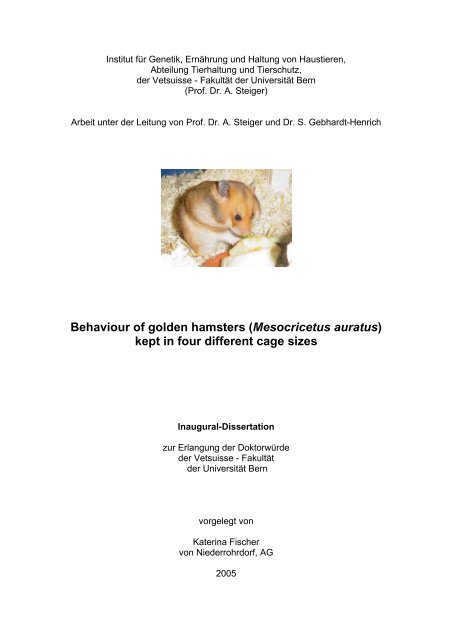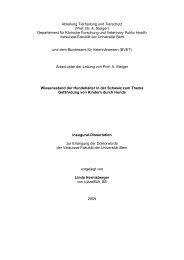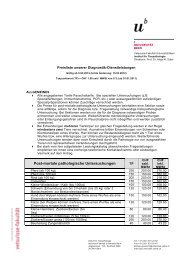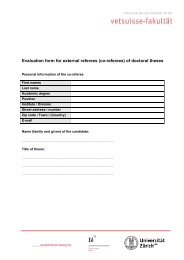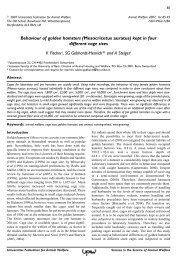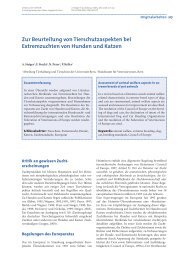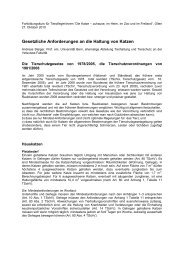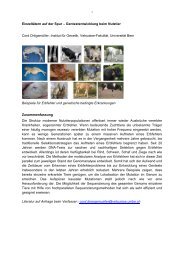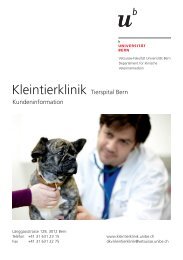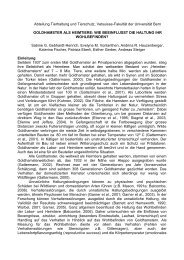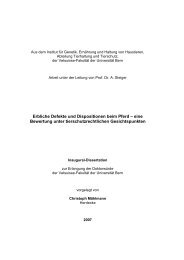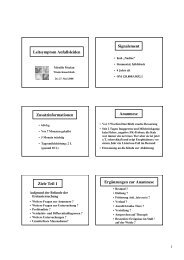Behaviour of golden hamsters (Mesocricetus auratus) - Vetsuisse ...
Behaviour of golden hamsters (Mesocricetus auratus) - Vetsuisse ...
Behaviour of golden hamsters (Mesocricetus auratus) - Vetsuisse ...
You also want an ePaper? Increase the reach of your titles
YUMPU automatically turns print PDFs into web optimized ePapers that Google loves.
Institut für Genetik, Ernährung und Haltung von Haustieren,Abteilung Tierhaltung und Tierschutz,der <strong>Vetsuisse</strong> - Fakultät der Universität Bern(Pr<strong>of</strong>. Dr. A. Steiger)Arbeit unter der Leitung von Pr<strong>of</strong>. Dr. A. Steiger und Dr. S. Gebhardt-Henrich<strong>Behaviour</strong> <strong>of</strong> <strong>golden</strong> <strong>hamsters</strong> (<strong>Mesocricetus</strong> <strong>auratus</strong>)kept in four different cage sizesInaugural-Dissertationzur Erlangung der Doktorwürdeder <strong>Vetsuisse</strong> - Fakultätder Universität Bernvorgelegt vonKaterina Fischervon Niederrohrdorf, AG2005
Von der <strong>Vetsuisse</strong>-Fakultät der Universität Bern auf Antragvon Pr<strong>of</strong>. Dr. A. Steiger als Dissertation genehmigt.Bern,Der Dekan der<strong>Vetsuisse</strong>-Fakultät der Universität Bern
Table <strong>of</strong> contentPage1 Zusammenfassung 12 <strong>Behaviour</strong> <strong>of</strong> <strong>golden</strong> <strong>hamsters</strong> (<strong>Mesocricetus</strong> <strong>auratus</strong>) kept infour different cage sizes 4Abstract 5Introduction 6Methods 8Animals and housing 8Procedure and Measurements 9Procedure 9Running-wheel activity 10<strong>Behaviour</strong> 11Statistics 11Results 12<strong>Behaviour</strong> 12Running wheel 12Wire gnawing 14Grooming 16Location 16On house 17Open space 18Body weight 18Stress hormones and organs 20Discussion 21Conclusions 27References 283 Can we tell <strong>hamsters</strong> are stressed by measuring their cortisol levels? 32Abstract 33Introduction 34Methods 35Animals and husbandry 35Hormonal analyses 36Statistics 36Results 38Hormones 38Corticosterone 38Cortisol 39Cortisol/Corticosterone ratio 41ACTH 42Sampling effects 42ACTH-Challenge Test 44Discussion 45Conclusions 48References 494 Appendix 525 Danksagungen 56
1 ZusammenfassungVerglichen mit der geschätzten Territoriumsgrösse wildlebender Goldhamster(<strong>Mesocricetus</strong> <strong>auratus</strong>) werden domestizierte Goldhamster häufig in sehr kleinenKäfigen gehalten. Werden sie als Haustiere gehalten, sind die Käfige zwar meistensetwas grösser als Laborkäfige (Makrolon Typ 4 = 1’800 cm 2 ), aber dennoch relativklein. Im Rahmen einer Expedition der Universität Halle (Deutschland) und Aleppo(Syrien) haben Gattermann et al. (2001) das natürliche Habitat von Goldhamsternuntersucht. Bewohnte Hamsterbauten waren mindestens 118 m voneinanderentfernt. In Anbetracht dieser Distanz erscheint die Käfiggrösse als wichtiger Faktorfür das Wohlbefinden von Goldhamstern.Ziel der vorliegenden Arbeiten waren Untersuchungen des Verhaltens undmorphologischer sowie physiologischer Parameter bei der Haltung vonGoldhamstern auf verschieden grossen Grundflächen. Weiterhin wurde der Einflussverschiedener Stressfaktoren auf die Goldhamster untersucht.Das erste Publikationsmanuskript „<strong>Behaviour</strong> <strong>of</strong> <strong>golden</strong> <strong>hamsters</strong> (<strong>Mesocricetus</strong><strong>auratus</strong>) kept in four different cage sizes“ (Kapitel 2) befasst sich mit dem Verhaltenund mit weiteren Parametern bei Goldhamstern auf verschieden grossenGrundflächen. Mit Hilfe von Videoaufnahmen wurde das Verhalten von 60 weiblichenGoldhamstern, die in drei Durchgängen à 15 Hamster während 13 Wochen inKäfigen mit vier verschiedenen Grundflächen (1’800 cm 2 , 2’500 cm 2 , 5’000 cm 2 , und10’000 cm 2 ) einzeln gehalten wurden, verglichen und auf ihre Tiergerechtheit geprüft.Alle Käfige waren mit einem Holzhäuschen, einem Laufrad, einem Sandbad,Futterschale, Trinkflasche, Ästen, Heu, Papiertüchern und einer Kartonrolle1
eingerichtet. Die Laufradaktivität wurde rund um die Uhr registriert. Eingestreutwurden die Käfige mit Hobelspänen, die 15 cm hoch eingefüllt wurden. Insgesamtwurden drei Videoaufnahmen (Wochen 3, 6, 10) gemacht und das Verhalten derHamster in den verschieden grossen Käfigen wurde anschliessend ausgewertet. InWoche 11 und 12 wurden die Hamster an zwei aufeinander folgenden Tagen in derLichtphase (Schlafphase) gestresst (Wecken, „Handling“, Herumjagen, Austauschender Einstreu, Lärm, etc.). Zu 4 verschiedenen Zeitpunkten (Wochen 0, 2, 8, 13)wurden die Tiere gewogen. Am Schluss wurden die Hamster euthanasiert, es wurdeBlut gewonnen und die Cortisol-, Corticosteron- und ACTH-Konzentrationen wurdengemessen.In den vier Käfiggrössen konnten keine signifikanten Unterschiede in derLaufradaktivität festgestellt werden. An den zwei Tagen nach den Stress-Prozedurenliefen die Hamster signifikant länger im Laufrad als an den zwei Tagen vor demStress und während dem Stress. Stereotypes Gitternagen, häufig als ein Indikator fürungenügende Haltungsbedingungen verwendet, wurde in allen vier Käfiggrössenbeobachtet. Mit zunehmender Käfiggrösse haben die Frequenz und die Dauer vonstereotypem Gitternagen signifikant abgenommen. Die erhöhte Plattform auf demHolzhäuschen wurde vermehrt von Hamstern aus den kleinen Käfigen genutzt. Dieskönnte durch ein grösseres Bedürfnis nach zusätzlichem Platz erklärt werden. DieGewichtszunahme bis zum Projektende war signifikant höher je kleiner der Käfig,beruhte aber nicht auf einem höheren Fettansatz der Tiere. Da sich die Hamsterjedoch noch im Wachstum befanden, besteht die Möglichkeit, dass dieüberschüssige Energie zu einem späteren Zeitpunkt zu verfetteten Tieren führenkönnte.2
Aus den Resultaten schliessen wir, dass ein Käfig von 10’000 cm 2 oder grösser fürGoldhamster zu empfehlen ist. Die Käfige können zudem mit mehr Strukturenangereichert werden, so dass die Hamster mehr Beschäftigungsmöglichkeitenhaben. Eine tiefere Einstreu ist ebenfalls zu empfehlen, wie aus der paralleldurchgeführten Dissertationsarbeit von A. Hauzenberger (2005) entnommen werdenkann. Zusätzlich empfehlen wir, dem Goldhamster ein Sandbad zur Verfügung zustellen, da es von allen Hamstern, unabhängig von der Käfiggrösse, sehr häufiggenutzt wurde und für ihr Wohlbefinden von Bedeutung zu sein scheint.Das zweite Publikationsmanuskript „Can we tell <strong>hamsters</strong> are stressed by measuringtheir cortisol levels?“ (Kapitel 3) befasst sich mit den Schwierigkeiten, einenallfälligen Stresszustand mittels physiologischer Parameter zu erfassen. Bei denweiblichen Tieren im Versuch wurden signifikante Unterschiede in denHormonkonzentrationen Cortisol, Corticosteron und ACTH zwischen den dreiVersuchsdurchgängen gefunden. Die Käfiggrösse hatte keinen Effekt auf dieHormonwerte. Die Hormonwerte für Goldhamster sind in der Literatur uneinheitlichund zeigen grosse Varianzen auf. Die Hormonwerte im Blut sind sehr empfindlichgegenüber äusseren Einflüssen. Physiologische Stressmessungen müssen deshalbmit Vorsicht interpretiert werden und sollten immer im Zusammenhang mit anderenParametern, z. B. dem Verhalten, beurteilt werden.3
2 <strong>Behaviour</strong> <strong>of</strong> <strong>golden</strong> <strong>hamsters</strong> (<strong>Mesocricetus</strong> <strong>auratus</strong>) kept in fourdifferent cage sizesThis manuscript will be submitted to Animal Welfare<strong>Behaviour</strong> <strong>of</strong> <strong>golden</strong> <strong>hamsters</strong> (<strong>Mesocricetus</strong> <strong>auratus</strong>) kept in fourdifferent cage sizesKaterina Fischer, Sabine G. Gebhardt-Henrich, Andreas Steiger<strong>Vetsuisse</strong> Faculty Bern, Institute <strong>of</strong> Animal Genetics, Nutrition and Housing,Division <strong>of</strong> Animal Housing and Welfare, P.O. Box, CH-3001, Bern, SwitzerlandCorrespondent author:Katerina Fischer, <strong>Vetsuisse</strong> Faculty Bern, Institute <strong>of</strong> Animal Genetics, Nutrition andHousing, Division <strong>of</strong> Animal Housing and Welfare, Bremgartenstrasse 109a,P.O. Box, CH-3001 Bern, SwitzerlandPhone: +41-31-631-23-66Fax: +41-31-631-26-40e-mail: katerina.fischer@itz.unibe.ch4
AbstractCages for laboratory <strong>hamsters</strong> as well as for pet <strong>hamsters</strong> are usually quite small.Using video recordings, the behaviour <strong>of</strong> sixty female <strong>golden</strong> <strong>hamsters</strong> (<strong>Mesocricetus</strong><strong>auratus</strong>) housed in four different cage sizes was compared in order to drawconclusions about their welfare. The cage sizes were 1,800 cm 2 , 2,500 cm 2 , 5,000cm 2 , and 10,000 cm 2 . Enrichment items and litter depth (15 cm) were standardisedand all cages were equipped with a running wheel. There were no significantdifferences in running wheel activity. In all cage sizes stereotypic wire gnawing wasobserved, but the <strong>hamsters</strong> in the small cages did it significantly longer and morefrequently. In small cages more <strong>hamsters</strong> used the additional platform <strong>of</strong> theirwooden houses than in big cages, which could suggest that they need more space.Therefore, we recommend cages with a minimal ground floor area <strong>of</strong> 10,000 cm 2 for<strong>golden</strong> <strong>hamsters</strong>.Keywords: animal welfare, <strong>golden</strong> hamster, cage size, stereotypy, wire gnawing,running wheel5
IntroductionHamsters are common laboratory animals in biomedical research as well as popularpet animals. Nevertheless, little work has been done with the specific intent <strong>of</strong>improving their housing conditions, especially for pet animals. Exceptions are thework by Kuhnen (1999a), Bantin and Sanders (1989) on cage size, Mrosovsky et al.(1998) on running wheel choice by Syrian <strong>hamsters</strong>, and Reebs and Maillet (2003)on environmental enrichment. Reebs and Maillet (2003) showed that there werefewer daily revolutions, shorter wheel running activity phases, and delayed runningactivity onsets in <strong>hamsters</strong> housed in multiple-cage systems enriched with a runningwheel and commercial wooden toys compared with <strong>hamsters</strong> housed in single cageswith a running wheel, without other enrichments. Mrosovsky et al. (1998) found that<strong>golden</strong> <strong>hamsters</strong> ran more in wheels with the floor covered by a plastic mesh than inwheels with the usual rods. This preference was evident both in tests with a singlewheel and in tests when the animals were <strong>of</strong>fered a choice between two wheels. Inthe case <strong>of</strong> Kuhnen (1999a), <strong>golden</strong> <strong>hamsters</strong> were individually housed in fourdifferent cage sizes from 200 cm² to 1,815 cm². Increasing cage size increased themean febrile response, while the mean baseline rectal temperature decreased. Theresults indicate that housing in small cages induces chronic stress, which affectsthermoregulation. The cages are common for laboratory rodents. Pet <strong>golden</strong><strong>hamsters</strong> are usually kept in cages at least as big as a Macrolon 4 type laboratorycage, which is 1,800 cm². In Switzerland this is the statutory minimum size accordingto the actual ordinance for the protection <strong>of</strong> animals. The cage size is <strong>of</strong> greatimportance for the welfare <strong>of</strong> the animals, as shown in the studies mentioned above.The pets spend their whole life in their cages and should have the possibility toperform all their behavioural needs. Stress levels should be kept as low as possible.6
In a joint expedition by the universities <strong>of</strong> Halle (Germany) and Aleppo (Syria),Gattermann et al. (2001) explored natural hamster habitats. The closest distancebetween occupied hamster burrows was 118 m. A mean tunnel length <strong>of</strong> 199.5 ±92.6 cm and a mean burrow depth <strong>of</strong> 64.8 ± 17.6 cm were observed (Gattermann etal., 2001). This shows that the natural territory <strong>of</strong> a hamster is much bigger than anycage. Laboratory <strong>hamsters</strong> compared with wild caught <strong>hamsters</strong> did not show anydifferences in behaviour (Gattermann, 2000). Despite domestication for decades,they are capable to survive in a semi natural environment as demonstrated byGattermann (2000). Therefore, domesticated <strong>hamsters</strong> might need more space thanwe commonly <strong>of</strong>fer them.The aim <strong>of</strong> this study was to show differences in the behaviour <strong>of</strong> <strong>golden</strong><strong>hamsters</strong> housed in different sized cages and to draw conclusions about theirwelfare. Furthermore the response <strong>of</strong> the running wheel activity to different stressorswas analysed. The study focused especially on pet <strong>hamsters</strong>, therefore cage sizesused were much bigger than common laboratory cages. Areas <strong>of</strong> cages used in thisstudy were 1,800 cm², 2,500 cm², 5,000 cm² and 10,000 cm². The area <strong>of</strong> thesmallest cage was chosen because it was the statutory minimum in Switzerland. Anarea <strong>of</strong> 2,500 cm² is a commonly used size. The Swiss Animal Protection (SAP)demands a minimum area <strong>of</strong> 5,000 cm² and they recommend a cage <strong>of</strong> more than10,000 cm² (Lerch-Leemann, 2002).7
MethodsAnimals and housing conditionsThe sixty female <strong>golden</strong> <strong>hamsters</strong> used for this project were progeny <strong>of</strong> the strain Crl:LVG (SYR) from Charles River, Germany. During one year the sixty <strong>hamsters</strong> werebred in three series <strong>of</strong> 20 <strong>hamsters</strong> each. A photoperiod <strong>of</strong> 12h light, 12h dark, dawnat 1300h was maintained. The light decreased from 280 Lux within half an hour tomaximal 5 Lux. Room temperature was 21±2°C, relative humidity was not regulated,but was between 25% and 59%. Hamsters were bred in cages with a wire top andplastic bottom (length x width x height: 95 cm x 57 cm x 45 cm) without a runningwheel. At the age <strong>of</strong> 24 to 30 days <strong>hamsters</strong> were placed singly into four differentsized cages (App. I to III). Size 1 was: 32 cm x 57 cm x 45 cm (length x width xheight), (approx. 1,800 cm 2 ); size 2: 44 cm x 57 cm x 45 cm, (approx. 2,500 cm 2 ),size 3: 95 cm x 57 cm x 45 cm, (approx. 5,000cm 2 ), and size 4: 105 cm x 95 cm x 45cm (approx. 10,000 cm 2 ). All cages were furnished with a wooden nest box (20 cm x14 cm x 14 cm), litter (depth: 15 cm), hay, paper towel, cardboard tubes, twigs, asand bath (diameter: 16 cm) and a running wheel (diameter: 30 cm, width: 10 cm).Commercial pet hamster food (Witte Molen®, NL-Meeuwen) and water were <strong>of</strong>feredad lib. This diet was amended by dry cat food and vitamin and mineral supplements(Marienfelde Vitakalk). In addition, fresh fruits and vegetables were added every day.Litter was never changed completely. Only the dirty parts <strong>of</strong> the litter were changedwhen necessary. Due to space limitations, the project was made in 3 series. Fivecages <strong>of</strong> each size were used simultaneously. In each <strong>of</strong> the three series, 20<strong>hamsters</strong> were distributed singly in the 20 cages. If possible, <strong>hamsters</strong> <strong>of</strong> one litterwere placed randomly, but according to their body mass, in cages <strong>of</strong> 4 different sizes.The experiment was approved by the Cantonal Office <strong>of</strong> Agriculture and Nature.8
Procedure and MeasurementsProcedureIn week 0, at weaning, <strong>hamsters</strong> were approximately 4 weeks <strong>of</strong> age. During theexperiment they were weighed repeatedly (Fig. 1). The body length (snout to tip <strong>of</strong>tail) was measured before termination on the anaesthetized animal, which wasstretched out on a ruler. The body condition <strong>of</strong> the <strong>hamsters</strong> was calculated as bodyweight in proportion to body length (body weight in week 13/length 3 ), which is adegree <strong>of</strong> fat tissue. Hamsters were video-taped, between 15:30 and 18:30 p.m., i.e.2:30 hours after dawn (Fig. 1). In weeks 11 and 12 each hamster was stressed ontwo following days by shaking the cage, chasing, handling, habitation in a smallcardboard box for 30 minutes and loud music for three to five minutes. Additionallyon the first day <strong>of</strong> stress half <strong>of</strong> the litter was changed, while on the second day aconfrontation with another hamster was performed. Thirteen weeks after weaning<strong>hamsters</strong> were decapitated after Is<strong>of</strong>lurane-anaesthesia. Blood was collected andsent to Alomed, Analytical Laboratory Dr. W. Müller, (Germany), for analyses <strong>of</strong>corticosterone, cortisol and ACTH. Organs (adrenals, heart, liver, kidney and spleen)were weighed and checked for differences in the 4 cage sizes. Special attention wasgiven to the weights <strong>of</strong> adrenals as an indicator <strong>of</strong> stress. Gastric mucosa wascontrolled for ulcers. All brains were examined for hydrocephalus internus.9
weaningvideorecordingvideorecording0 1 2 3 4 5 6 7 8 9 10 11 12 13Project-weekvideorecording▼* * **▼**end <strong>of</strong>project*body weight▼stress application**blood collection and autopsyFig. 1 Time table <strong>of</strong> the experiment. The stress treatment was conducted over 2 weeks.Running-wheel activityRevolutions <strong>of</strong> running wheels were constantlyregistered by the Chronobiology Kit (StanfordS<strong>of</strong>tware Systems). For the analysis <strong>of</strong> the runningwheelactivity we used the median <strong>of</strong> the dailyrevolutions until week 10, before the <strong>hamsters</strong> werestressed. From time to time some <strong>hamsters</strong> blockedthe running-wheel with litter and in some cases therunning-wheel was not functioning or the transmission <strong>of</strong> data failed. These datawere excluded from the analyses. Furthermore, all running-wheel data <strong>of</strong> onehamster from cage size 2 was excluded because the transmission <strong>of</strong> the runningwheeldata failed consistently. For analyses <strong>of</strong> the effects <strong>of</strong> stress the mean number<strong>of</strong> revolutions <strong>of</strong> the 2 days during stress, as well as 2 days before and 2 days afterstress, were analysed.10
<strong>Behaviour</strong>A total <strong>of</strong> thirty minutes <strong>of</strong> the taped behaviour was analysed using the ObserverVersion 5.0 (Noldus). The thirty minutes <strong>of</strong> observation were split into six five-minutesequences during which the hamster stayed outside the house, i.e. the hamster wasnot sleeping and was visible. If possible, the sequences were spaced equally overthe three recorded hours. If a hamster was not active or visible during the whole 3recorded hours, so that observation sequences could not be spaced equally, a total<strong>of</strong> thirty minutes <strong>of</strong> the time the <strong>hamsters</strong> were visible on the tape was analysed. Insome cases (4%, 7 <strong>hamsters</strong>, each with 1 observation) <strong>hamsters</strong> were active for lessthan 30 minutes, thus their observational data was based on the time they wereactive. One <strong>of</strong> the <strong>hamsters</strong> in cage size 2 was never active during the recorded time,so behavioural data for this animal are missing. The behavioural data wereexpressed as the percentage <strong>of</strong> total observed time for all three observations (totalpercent duration). For each observation separately a repeated measure analysis wasmade. Mean duration (sec.) and frequency (bouts) were analysed, when the percentduration suggested interesting results. <strong>Behaviour</strong>s and locations were classified asdescribed in App. IV, following Vonlanthen (2003).StatisticsAll statistical analyses were made with NCSS 2001, or SAS. Data and residuals werechecked for normality and transformed if necessary and possible. Transformationsand tests are described in the results. The series and the occurrence <strong>of</strong>hydrocephalus were included as factors in the analyses <strong>of</strong> behavioural data and arementioned if they were significant. Correlations were calculated by using Spearmanrank correlations coefficients.11
Results<strong>Behaviour</strong>Hamsters devoted most <strong>of</strong> their observed activity to wheel-running. The remainingtime was spent mainly on resting, rearing and grooming (Fig. 2). Correlationsbetween the different behaviours (Tab. 1) were mainly positive, which indicates thatthe <strong>hamsters</strong> were generally active and showed various behaviours. However, themore time a hamster spent wheel-running, the less it spent with other activities.Likewise, the more time a hamster spent wheel-running, the less time he spent wiregnawing or climbing. In contrast, climbing was positively correlated to wire gnawing.The important results <strong>of</strong> the different behavioural activities are listed below. Theoccurrence <strong>of</strong> hydrocephalus as a main factor was never significant.706050403020100wheel-runningrestingrearinggroomingwire-gnawingfeedingrunninggnawingclimbingdiggingdrinking1,800 cm² 2,500 cm² 5,000 cm² 10,000 cm²Fig. 2 Total percent duration <strong>of</strong> observed behaviours in the different cage sizes.12
Tab.1 Correlation between the durations <strong>of</strong> various behaviours+ or - correlation r s >0.3, ++, or -- correlation r s > 0.6, +++, or --- correlation r s > 0.9, blank fields showno significant correlation.<strong>Behaviour</strong>wheelrunningresting rearing grooming wiregnawingfeeding running gnawing climbingwheelrunning- - - - - - - - - - - -resting 0.000038 + +rearing 0.000000 0.002952 ++ + + + +groomingwire0.000000 0.000000 +++ + + ++gnawingfeeding 0.000000 0.000001 0.000000 + + ++running 0.000000 0.000433 0.000132 0.000397 + ++gnawing 0.000109 0.009750 0.011624 0.000588 0.001295 0.002035 +climbing 0.000000 0.000001 0.000000 0.000000 0.000000 0.001828The important results <strong>of</strong> the different behavioural activities are listed below.The occurrence <strong>of</strong> hydrocephalus as a main factor was never significant.Running-wheelAll <strong>hamsters</strong> used the running-wheel. The average distance was 8.3 km per day(8872 revolutions). The minimum per animal was on average 0.63 km per day; themaximum was 18.56 km per day. During the 10 weeks before the stress treatment,running wheel activity <strong>of</strong> <strong>hamsters</strong> was similar in all 4 cage sizes (F = 0.88, N = 59, P= 0.4552). The stress treatment affected running wheel activity significantly in allcage sizes. During the two days after stress treatment running-wheel activity wassignificantly higher than before and during stress treatment (Repeated Measures-ANOVA: F = 5.31, N = 45, P = 0.0068) (Tab. 2).The total percent duration <strong>of</strong> wheel-running seen in the observationscorrelated with the median <strong>of</strong> the revolutions per day measured with theChronobiology Kit (r s = 0.60, N = 58, P < 0.0001).13
Tab. 2 Post-hoc comparisons <strong>of</strong> running-wheel activity 2 days before (2BS), 2 days during (2DS) and2 days after (2AS) stress treatment.Comparison T-Value p-Value Revolutions/day2AS vs. 2BS and 2DS2AS vs. 2BS2AS vs. 2DS2BS vs. 2DST = 3.2059T = 2.2127T = 3.3436T = 1.1617p = 0.001823p = 0.029267p = 0.001177p = 0.248200+1188+2115.36+927.36Wire gnawingCompared with gnawing at various structures(cardboard tube, twigs, house, etc.) the <strong>hamsters</strong>generally gnawed at the wire for longer periods(Wilcoxon Signed- Rank Test: Z = 4.3439, P
duration <strong>of</strong> wire gnawing was positively correlated with final body weight (r s = 0.43, N= 22, P = 0.0434).frequency <strong>of</strong> wire gnawing (bouts)100.066.733.30.00.0 1,800 2,500 5,00010,000cage size [cm 2 ]Fig. 3 Total frequency <strong>of</strong> wire gnawing in the different cage sizes. Raw data are shown, for theanalyses the data were square root transformed.wire gnawing (% <strong>of</strong> total Observation)35.023.311.70.01,800 2,500 5,000 10,000cage size [cm 2 ]Fig. 4 Duration <strong>of</strong> wire gnawing (% <strong>of</strong> the total time <strong>of</strong> observation) in the 4 cage sizes. The boxrepresents the middle 50% <strong>of</strong> the data, the horizontal line is the median. The vertical lines show 1.5times the interquartile range; dots are values outside this range. The stars represent the mean value<strong>of</strong> total duration, which was 19.3 % for 1,800 cm 2 , 14.5 % for 2,500 cm 2 , 9.55 % for 5,000 cm 2 and 4.2% for 10,000 cm 2 . Raw data are shown, for the analyses the data were square root <strong>of</strong> 2*arsintransformed.15
GroomingAll <strong>hamsters</strong> were observed grooming. Forty-six out <strong>of</strong> 60 <strong>hamsters</strong> showedgrooming in the sand bath. A minimum <strong>of</strong> 0.02 % <strong>of</strong> total observed time and amaximum <strong>of</strong> 13.74 % <strong>of</strong> total observed time was spent on this behaviour. Nosignificant differences were observed between grooming in the sand bath andgrooming in other localities. Although the area <strong>of</strong> the sand bath was only 2 % <strong>of</strong> thearea <strong>of</strong> the largest cage, <strong>hamsters</strong> in the biggest cages spent more than 12 % <strong>of</strong>grooming in the sand bath. In the smallest cages 19 % <strong>of</strong> grooming was performed inthe sand bath while the area <strong>of</strong> the sand bath was 11 % <strong>of</strong> the cage area. But therewere no significant differences between cage sizes (GLM-ANOVAs: P > 0.1).There were no significant differences in the duration <strong>of</strong> running or restingamong the four cage sizes.LocationHamsters stayed most <strong>of</strong> the observed time inside the running wheel (Fig. 5). Theremaining time was spent in the open space, at the wire, in the food bowl or in thesand bath. Mostly positive correlations were found between the time that was spentin the locations shown in figure 5, showing that the <strong>hamsters</strong> used the whole cageand its structures (data not shown). The running wheel usage though was negativelycorrelated (P < 0.007) with the usage <strong>of</strong> these various locations.16
806040200in running-wheelopen spacewirefood bowlsand bathon houseon/beh wheel1,800 cm² 2,500 cm² 5,000 cm² 10,000 cm²Fig. 5 Total percent duration <strong>of</strong> presence in most frequently visited locations in the different cagesizes. All other locations were visited rarely.On houseMore <strong>hamsters</strong> were observed on top <strong>of</strong> the house in smallcages (χ 2 3 = 22.05, p < 0.0001, Tab. 3), but total percentduration as well as total frequency revealed no differencesamong cage sizes (P > 0.1)Tab. 3 Number <strong>of</strong> <strong>hamsters</strong> observed on top <strong>of</strong> the house (X 2 3 = 22.05, p < 0.0001).Cage size [cm 2 ] observed onhouse1,800142,500125,000510,0004Total35not observed onhouse12101124N151415155917
Open spaceUsage <strong>of</strong> open space was performed for longer time periods in big cages (F = 3.66, N= 59, P = 0.0187). There were no significant differences in the duration <strong>of</strong> usage <strong>of</strong>other localities.Body weightAt week 0 body weights were similar in all four cage sizes (ANOVA, logtransformation:F = 2.65, N = 60, P = 0.143). The series had a significant influence onbody weight (P < 0.05) with the exception <strong>of</strong> week 8 (Fig. 6). Hamsters from largerlitters were significantly lighter throughout the experiment (Tab. 4). The effect <strong>of</strong>weaning age was significant in the first three body weight measurements, but not inweek 13. Cage size never affected body weights significantly, but showed a tendencytowards higher weights in big cages in week 13. Weight gain from weaning until week13 was significantly smaller the bigger the cage (ANOVA: F = 4.03, N = 57, P =0.013) (Fig. 7). Series, age <strong>of</strong> weaning and litter size had no effect on weight gain.The body condition (body weight in week 13 / length 3 ), was not significantly differentbetween cage sizes (ANOVA: F = 1.93, N = 57, P = 0.1389). During autopsy, nodifference in the amount <strong>of</strong> fat was noticed.Tab. 4 ANOVAs <strong>of</strong> body weights at the 4 measured times with cage size and series as factors andlitter size and age at weaning as covariates. N = 60, week 13: N = 57. No significant interactionsoccurred.Project-week Litter size Weaning-age Cage size0F=6.59 P=0.0135 F=34.17 P0.5P>0.4P=0.074318
ody weight at weaning (week 0)70.0052.5035.00Series123P > 0.000117.500.001,800 2,500 5,000 10,000cage size [cm 2 ]Fig. 6 Body weight at weaning in all cage sizes differed significantly among the three series: F =35.14, N = 60, P < 0.0001 covariates were: litter size and weaning age. Raw data are shown, for theanalyses the data were log-transformed.Weight gain week 0 - 13130.0097.5065.0032.500.001,800 2,500 5,000 10,000cage size [cm 2 ]Fig. 7 ANOVA <strong>of</strong> weight gain from weaning to week 13 with cage size and series as factor variablesand litter size and weaning age as covariates showed an effect <strong>of</strong> cage size, F 3, 43 = 4.03, P = 0.013.The box represents the middle 50% <strong>of</strong> the data, the horizontal line is the median. The vertical linesshow 1.5 times the interquartile range; dots are values outside this range.19
Stress hormones and organsNeither stress hormones nor the coefficient <strong>of</strong> cortisol/corticosterone differedbetween cage sizes (P > 0.1) (see also Gebhardt et al., in prep, Chapter 3).No differences were found in organ weights including the weights <strong>of</strong> the adrenalglands.20
DiscussionHamsters spent most <strong>of</strong> the observed time wheel running. The running wheel activitywas the same in all four cage sizes. This might indicate that running in the wheel isvery important to them. A bigger cage obviously has no attraction that competes withwheel running. Gebhardt-Henrich et al. (2005) showed that the degree <strong>of</strong> wheelrunning was adapted to individual circumstances, since <strong>hamsters</strong> reduced or evenstopped wheel running during breeding. Additionally, the running wheel had abeneficial effect on the well-being <strong>of</strong> the <strong>hamsters</strong>, since it significantly decreasedstereotypic wire gnawing. Our results confirm their findings. The longer wheel runningwas performed, the less stereotypic wire gnawing was observed. Furthermore,<strong>hamsters</strong> which showed less wheel running seemed to compensate the need formovement with climbing. Nevertheless some scientists describe wheel running as astereotypic behaviour (see review by Sherwin, 1998) and therefore it is not clearwhether the provision <strong>of</strong> a running wheel should be mandatory for <strong>golden</strong> <strong>hamsters</strong>.Stereotypies are common indicators for poor welfare (e.g. review by Mason1991, Würbel 2001). Stereotypic behaviour is commonly defined by repetitive,unvarying behavioural patterns without obvious goal or function (Ödberg, 1987),when kept under barren housing conditions (Mason, 1991). Stereotypic wire gnawingis <strong>of</strong>ten observed in captive rodents (Würbel and Stauffacher 1996, 1997, 1998,Wiedenmayer 1997, Waiblinger 1999).Wire gnawing <strong>of</strong> <strong>hamsters</strong> in the present study was considered to bestereotypic because it was repetitive, invariant and was performed at a particular spoton the wire top <strong>of</strong> the cage (similarly in mice, Würbel et. al. 1996). Additionally it waswithout function because wire gnawing was considered to develop from outside-21
directed exploration, which, after a steady ineffectiveness, no longer contributed toexploration.Wiedenmayer (1995) stated that 12 seconds was the critical minimum time forstereotypic digging in gerbils. Normal digging was never performed for the sameamount <strong>of</strong> time. Similarly, we stated a total duration <strong>of</strong> wire gnawing <strong>of</strong> less than 1 %<strong>of</strong> total observation time as non-stereotypic, which is less than 54 seconds over anobservation time <strong>of</strong> 90 minutes. Some <strong>hamsters</strong> were seen to bite into the wireshortly while passing the wire but then immediately walked on.As shown in the results, <strong>hamsters</strong> clearly gnawed longer and more frequentlyon the wire than on other things. This was not expected, since it is not a naturalbehaviour <strong>of</strong> <strong>hamsters</strong>. Gnawing on the cardboard tube, on twigs or on the woodenhouse serves a purpose, since it is helpful for abrasion and cleaning <strong>of</strong> the teeth.Some <strong>hamsters</strong> fractionalised the cardboard tube and used it as nest material. Wiregnawing though seemed to be ineffective and senseless. It could not be prevented byproviding natural material to chew on, so wire gnawing and gnawing at objectspresumably had a different cause and / or function. Wire gnawing might be anattempt to escape from the cage (similarly in mice, Würbel et al. 1998a, 1998b).The results from this study indicate that housing in big cages improved thewelfare <strong>of</strong> the <strong>hamsters</strong> because it resulted in less stereotypic wire gnawing. Thebiggest cage with a size <strong>of</strong> 10,000 cm 2 was the one with the shortest wire gnawingduration and the lowest frequency (bouts). Duration and frequency <strong>of</strong> wire gnawing in10,000 cm 2 was half <strong>of</strong> the duration and frequency in 5,000 cm 2 cages. If this is takeninto account, the required minimum <strong>of</strong> the Swiss Animal Protection (SAP) <strong>of</strong> 5,000cm 2 seems still to be too small. However, although <strong>hamsters</strong> in small cages showedmore wire gnawing than <strong>hamsters</strong> housed in bigger cages, wire gnawing occurred in22
all cages. This suggests that even a cage <strong>of</strong> more than 10,000 cm 2 is too small forfemale <strong>golden</strong> <strong>hamsters</strong>.All cages were furnished with the same structures (enrichment). There was alot <strong>of</strong> free space in the big cages, therefore the <strong>hamsters</strong> had the possibility to runmore and faster. But the possibilities <strong>of</strong> preoccupation were the same in all cages.This could be another reason why wire gnawing was performed even in the bigcages. It would be interesting to know whether stereotypic wire gnawing wouldpersist in big cages with more enrichment (e.g. wooden toys, cork caves, climbingpossibilities) and with a change <strong>of</strong> enrichments (Lambert et al., 2005, in mice).Ödberg (1987) found that an increase <strong>of</strong> cage size did not affect stereotyped jumpingin voles, whereas enrichment with twigs reduced it. Spangenberg et. al. (2005)housed rats either singly in small cages (1,092 cm 2 ) with only one black plastic tube,or in groups in larger cages (3,938 cm 2 ) which were provided with more and variousenrichment. Rats in the larger, more enriched cages displayed a more diversebehavioural repertoire which consisted <strong>of</strong> running, climbing and social behaviours.Compared with other studies, all cages in our study were enriched.Litter depth should be considered as another possibility <strong>of</strong> enrichment in<strong>golden</strong> <strong>hamsters</strong>. Hauzenberger (2005) found that <strong>golden</strong> <strong>hamsters</strong> in a litter depth<strong>of</strong> 40 cm showed less stereotypic wire gnawing than <strong>hamsters</strong> housed in 10 cm deeplitter, while in a litter depth <strong>of</strong> 80 cm no stereotypic wire gnawing was observed. All<strong>hamsters</strong> used the deep litter (either 40 cm or 80 cm) as a retreat possibility and builtburrows. Running wheel activity was higher in 10 cm deep litter. This suggests that acombination <strong>of</strong> a big cage with deep litter could be a great improvement <strong>of</strong> thewelfare <strong>of</strong> <strong>golden</strong> <strong>hamsters</strong>.The positive correlation between wire gnawing and climbing can be explainedby the preference <strong>of</strong> some <strong>hamsters</strong> to climb to a particular spot on the front or the23
top wire. Some <strong>hamsters</strong> used to climb while pausing during wire gnawing. Theyusually climbed up and down the front side <strong>of</strong> the wire top but then returned to thesame point and restarted wire gnawing. Outside directed exploratory climbing wasconsidered as the behavioural source <strong>of</strong> stereotypic wire gnawing in laboratory mice(Würbel et al., 1996).All <strong>hamsters</strong> used the sand bath for grooming regularly, but not exclusively.Most <strong>hamsters</strong> used to wallow in the sand. Thus a sand bath seems very importantfor the welfare <strong>of</strong> <strong>golden</strong> <strong>hamsters</strong>, whether housed in small or big cages. Certainly itcan also be recommended for laboratory conditions as a reasonable enrichment,since the sand can be changed along with litter, if necessary.The available free space was used in all cage sizes. Hamsters in big cagesused the whole ground area and the observed duration which they spent in the openspace was longer. They used to walk particularly along the walls, so that trails wereformed. Staying near the walls (called thigmotaxis) is common in rodents and is usedas an index <strong>of</strong> anxiety (Simon et al., 1994, in mice). Some <strong>hamsters</strong> built a big crop<strong>of</strong> litter in the middle <strong>of</strong> the cage and formed a trail through the middle <strong>of</strong> it, which leddirectly from the running wheel to the house.Although there was more open space in the big cages and the distancesbetween the locations were longer, so that <strong>hamsters</strong> could run more, runningduration did not differ significantly among cage sizes. Possibly, <strong>hamsters</strong> in big cagesran faster, which led to a similar duration <strong>of</strong> running.The occurrence <strong>of</strong> thigmotaxis is no argument against big cages. Due to thefact that there were only two possibilities for covering, the house and the space underand behind the running wheel, the <strong>hamsters</strong> could have been afraid <strong>of</strong> running in theopen space. But big cages can be enriched more than small cages, so that morepossibilities for covering can be given. Additionally more enrichment may lead to less24
stereotypic behaviour and can improve animal welfare (e.g. Ödberg, 1987 in bankvoles, Würbel et. al. 1998b in mice, Kuhnen 1999b in <strong>golden</strong> <strong>hamsters</strong>). The wellbeing <strong>of</strong> caged animals is affected by many factors (Bantin and Sanders, 1989).Weiss et al. (in Bantin and Sanders 1982) showed that rats prefer to live in bignarrow cages compared to big broad cages. Although our cages were much bigger,the shape <strong>of</strong> the cage could also be important for <strong>hamsters</strong>.The additional space on top <strong>of</strong> the wooden house was used by almost all<strong>hamsters</strong> in the two smallest cages. On the contrary only a few <strong>hamsters</strong> in thebigger cages used the elevated platform. Although duration and frequency were notsignificantly different, it suggests that <strong>hamsters</strong> in the two smallest cage sizes were inneed <strong>of</strong> additional space and did not use the ro<strong>of</strong> <strong>of</strong> the house only because it wasan elevated platform.It was ensured that <strong>hamsters</strong> were distributed equally in the four cage sizesaccording to body weight at weaning. Due to different litter sizes in the three series, asignificant influence <strong>of</strong> series on body weights was observed. Possible reasons forthe higher weight gain in small cages could be lower energy consumption and/ormore food intake. The analysis <strong>of</strong> the condition, as well as autopsy results showedthat the higher weight gain was not due to more fat tissue. Faster running in bigcages, which uses more energy, would explain higher energy consumption in bigcages. Hamsters in smaller cages were thus able to spend more energy on growth.Hamsters were still growing throughout the project. With an advanced age excessiveenergy can not be used for growth anymore. Then the additional fat tissue couldbecome a problem in small cages. The lack <strong>of</strong> a running wheel or another activitywith high energy expenditure could impair the condition additionally. Therefore, cagesizes 1 and 2 seem to be too small.25
Autopsies <strong>of</strong> the three <strong>hamsters</strong> that died during the project revealed that all <strong>of</strong>them had severe hydrocephalus internus, but there had been no symptoms to drawattention to these <strong>hamsters</strong> (Edwards et al., 2005). Hydrocephalus as a main factornever had a significant effect on any analysis. Nevertheless, the effect <strong>of</strong>hydrocephalus on the behavioural data is not completely clear. Projects on this topicare planed.26
ConclusionsSince <strong>hamsters</strong> showed stereotypic wire gnawing in cage sizes from 1,800 cm 2 until10,000 cm 2 the welfare <strong>of</strong> the <strong>hamsters</strong> even in the very large cages must have beenimpaired. Frequency and duration <strong>of</strong> wire gnawing significantly decreased withincreasing cage size. Thus, the welfare <strong>of</strong> pet <strong>golden</strong> <strong>hamsters</strong> might be improved byproviding enriched cages <strong>of</strong> at least 10,000 cm 2 . Further investigations should followon the behaviour and development <strong>of</strong> stereotypic wire gnawing <strong>of</strong> <strong>golden</strong> <strong>hamsters</strong> indifferently enriched cages.27
ReferencesBantin G.C. and Sanders P.D., 1989. Animal caging: Is big necessarily better? Anim.Technol. 40, 45-54.Edwards J.F., Gebhardt-Henrich, S.G., Fischer K., Hauzenberger A.R., Steiger, A.,2005. Hereditary hydrocephalus in laboratory-reared <strong>golden</strong> <strong>hamsters</strong>(<strong>Mesocricetus</strong> <strong>auratus</strong>). J. Vet. Pathol. (in press).Gattermann R., 2000. 70 Jahre Goldhamster in menschlicher Obhut – wie gross sinddie Unterschiede zu seinen wildlebenden Verwandten? Tierlaboratorium 23,86-99Gattermann R., Fritzsche P., Neumann K., Al-Hussein I., Kayser A., Abiad M., YaktiR., 2001. Notes on the current distribution and the ecology <strong>of</strong> wild <strong>golden</strong><strong>hamsters</strong> (<strong>Mesocricetus</strong> <strong>auratus</strong>). J. Zool., Lond. 254, 359-365Gebhardt-Henrich S.G., Vonlanthen, E.M, Steiger, A, 2005. How does the runningwheel affect the behaviour and reproduction <strong>of</strong> <strong>golden</strong> <strong>hamsters</strong> kept as pets?Appl. Anim. Behav. Sci. (in press).Hauzenberger A. R., 2005. The influence <strong>of</strong> Bedding Depth on <strong>Behaviour</strong> in GoldenHamsters (<strong>Mesocricetus</strong> <strong>auratus</strong>). Dissertation <strong>Vetsuisse</strong> Faculty, University <strong>of</strong>Bern, Switzerland.28
Kuhnen G., 1999a. The effect <strong>of</strong> cage size and enrichment on core temperature andfebrile response <strong>of</strong> the <strong>golden</strong> hamster. Lab. Anim. 33, 221–227.Kuhnen G, 1999b. The effect <strong>of</strong> housing conditions on the results <strong>of</strong> behavioural testsin <strong>golden</strong> hamster. Zoology 102 (Supp. II), 84Lambert T.J., Fernandez S. M., Frick K. M., 2005. Different types <strong>of</strong> environmentalenrichment have discrepant effects on spatial memory and synaptophysinlevels in female mice. Neurobiology <strong>of</strong> Learning and Memory, 83, 206-216Lerch-Lehmann C., 2002. Merkblatt Goldhamster. Swiss Animal Protection (SAP),www.schweizer-tierschutz-sts.chMason G. J., 1991. Stereotypies: a critical review. Anim. Behav. 41, 1015 - 1037.Mrosovsky, N., Salmon, P. A., Vrang, N. 1998. Revolutionary Science: an improvedrunning wheel for <strong>hamsters</strong>. Chronob. Intern. 15, 147-158.Ödberg F.O., 1987. The influence <strong>of</strong> cage size and environmental enrichment on thedevelopment <strong>of</strong> steretories in bank voles (Clethrimonys glareolus). Behav.Proc. 14, 155-173.Reebs S.G., Maillet D., 2003. Effect <strong>of</strong> cage enrichment on daily use <strong>of</strong> runningwheels by Syrian <strong>hamsters</strong>. Chronob. Intern. 20, 9–2029
Sherwin C.M., 1998. Voluntary wheel running a review and novel interpretation.Anim. Behav. 56, 11-27.Simon P., Dupuis R., Costentin J., 1994. Thigmotaxis as an index <strong>of</strong> anxiety in mice.Influence <strong>of</strong> dopaminergic transmissions. Behav. brain res. 61, 59-64.Spangenberg E.M.F., Augustsson H., Dahlborn K., Essén-Gustavsson B., 2005.Housing-related activity in rats: effects on body weight, urinary corticosteronelevels, muscle properties and performance. Lab. Anim. 39, 45-57.Vonlanthen E.M., 2003. Einflüsse der Laufradnutzung auf ausgewählte ethologische,morphologische und reproduktionsbiologische Parameter beim SyrischenGoldhamster (<strong>Mesocricetus</strong> <strong>auratus</strong>). Dissertation <strong>Vetsuisse</strong> Faculty,University <strong>of</strong> Bern, Switzerland.Waiblinger E., 1999. Welchen Einfluss haben die Zugabe von bearbeitbaremNestmaterial und der Ort der Futterdarbietung auf das Gitternagen beiMongolischen Rennmäusen (Meriones ungulatus) im Labor? Aktuelle Arbeitenzur artgemässen Tierhaltung 1999 , KTBL, Darmstadt, pp 49-59.Wiedenmayer C., 1995. The ontogeny <strong>of</strong> stereotypies in gerbils. DissertationPhilosophische Fakultät II der Universität Zürich, Switzerland.Wiedenmayer C., 1997. The early ontogeny <strong>of</strong> bar-gnawing in Laboratory gerbilsAnim. Welfare 6, 273-277.30
Würbel H., 2001. Ideal homes? Housing effects on rodent brain and behaviour.TRENDS in Neuroscience 24, 207-210Würbel H., Stauffacher M., 1996. Prevention <strong>of</strong> Stereotypy in Laboratory Mice :Effects on Stress Physiology and <strong>Behaviour</strong>. Physiol. Behav., 59 1163-1170.Würbel H., Stauffacher M., 1997. Age and weight at weaning affect corticosteronelevel and development <strong>of</strong> stereotypies in ICR-mice. Anim. Behav. 53, 891-900.Würbel H., Stauffacher M., 1998. Physical condition at weaning affects exploratorybehaviour and stereotypy development in laboratory mice. Behav. Proc 43,61-69.Würbel H., Stauffacher M., Holst D.v., 1996. Stereotyies in laboratory mice –Quantitative and Qualitative Description <strong>of</strong> the Ontogeny <strong>of</strong> „Wire-gnawing“and „jumping“ in Zur: ICR and Zur: Icr nu., Ethol. 102, 371 – 385.Würbel H., Freire R., Nicol C. J., 1998a. Prevention <strong>of</strong> stereotypic wire-gnawing inlaboratory mice: Effects on behaviour and implications for stereotypy as acoping response. Behav. Proc. 42, 61-72.Würbel H., Chapman R., Rutland C., 1998b. Effect <strong>of</strong> feed and environmentalenrichment on development <strong>of</strong> stereotypic wire-gnawing in laboratory mice.Appl. Anim. Behav. Sci. 60, 69-81.31
3 CAN WE TELL HAMSTERS ARE STRESSED BY MEASURINGTHEIR CORTISOL LEVELS?This manuscript will be submitted to Journal <strong>of</strong> Veterinary PathologyCAN WE TELL HAMSTERS ARE STRESSED BY MEASURINGTHEIR CORTISOL LEVELS?Sabine G. Gebhardt-Henrich, Katerina Fischer, Andrina R. Hauzenberger,Petra Keller, Andreas Steiger<strong>Vetsuisse</strong> Faculty Bern, Institute <strong>of</strong> Animal Genetics, Nutrition and Housing,Division <strong>of</strong> Animal Housing and Wlefare, P.O. Box, CH-3001, Bern, SwitzerlandCorrespondent author:Sabine G. Gebhardt, <strong>Vetsuisse</strong> Faculty Bern, Institute <strong>of</strong> Animal Genetics, Nutritionand Housing, Division <strong>of</strong> Animal Housing and Welfare, Bremgartenstrasse 109a,P.O. Box, CH-3001 Bern, Switzerland,Phone: +41-31-631-23-66, Fax: +41-31-631-26-40e-mail: sabine.gebhardt@itz.unibe.ch32
AbstractThe serum levels <strong>of</strong> corticosterone, cortisol, and ACTH were measured in male andfemale <strong>golden</strong> <strong>hamsters</strong> under different housing conditions. In males, the duration <strong>of</strong>handling until blood was taken (4.6 min. on average) significantly influenced theconcentrations <strong>of</strong> corticosterone, cortisol, and the ratio <strong>of</strong> cortisol/corticosterone.Handling times for females were only 2.3 minutes on average and no time effectswere found. However, significant effects <strong>of</strong> series were detected in both sexes. Nosignificant differences in the hormone levels were found due to housing treatments.Values <strong>of</strong> these hormones in the literature reveal large variation in this species. Dueto the sensitivity <strong>of</strong> hormonal measurements to (sometimes unknown andunavoidable) environmental factors interpretations <strong>of</strong> the stress levels <strong>of</strong> <strong>golden</strong><strong>hamsters</strong> based on these hormones must be made with caution.Keywords: cortisol, corticosterone, ACTH, stress, <strong>golden</strong> hamster33
IntroductionConcentrations <strong>of</strong> glucocorticoids are commonly used to infer the stress condition invarious species (see review by Buchanan, 2000). Unfortunately, poor repeatabilities<strong>of</strong> the measured values and contradictory results <strong>of</strong> several studies have raisedcontroversies about the value and applicability <strong>of</strong> the measurements <strong>of</strong> thesehormones (Rushen, 1991; Sandoe and Simonsen, 1992; Mason and Mendl, 1993).Several problems probably contribute to the difficulties <strong>of</strong> interpreting hormonalmeasurements in regard to stress and these have been sufficiently discussedelsewhere (Rushen, 1991; Buchanan and Goldsmith, 2004). In this note we want toreport experimental influences on hormonal measurements in <strong>golden</strong> <strong>hamsters</strong> inreference to published results on these species and to discuss the difficulties <strong>of</strong>measuring the stress condition in male and female <strong>golden</strong> <strong>hamsters</strong>.34
MethodsAnimals and husbandryForty-five male and sixty female <strong>golden</strong> <strong>hamsters</strong> (progeny <strong>of</strong> Crl: LVG (SYR) fromCharles River, Germany) were used in two experiments. In the experiment with male<strong>hamsters</strong>, animals were assigned to three groups, differing in bedding depth (b deep =80 cm, b medium = 40 cm and b low = 10 cm <strong>of</strong> bedding). In the experiment with female<strong>hamsters</strong>, animals were kept in four different cage sizes (1,800 cm 2, 2,500 cm 2 , and5,000 cm 2 , 10,000 cm 2 ). Due to space limitations the experiments were performed atthree different times. Additional <strong>hamsters</strong> for the validation <strong>of</strong> the ACTH test werekept in cages <strong>of</strong> 5,000 cm 2 . Food and water were <strong>of</strong>fered ad lib. Lighting was artificialwith 12h light 12 h dark. Temperatures were between 20 and 26º C. After weaning ataround 4 weeks <strong>of</strong> age, the <strong>hamsters</strong> were placed into the experimental groups andkept singly for 13 weeks. More details <strong>of</strong> the experiments are given in Fischer et al.(in preparation) and Hauzenberger et al. (in preparation). Thirteen weeks afterweaning <strong>hamsters</strong> were decapitated after is<strong>of</strong>lurane-anaesthesia (5%). The duration<strong>of</strong> catching the hamster out <strong>of</strong> its cage, the duration <strong>of</strong> anaesthesia, and the total timefrom first disturbance to decapitation (= total duration <strong>of</strong> blood sampling) wererecorded. The trunk blood was used for analyses <strong>of</strong> corticosterone, cortisol, andACTH. Hamsters <strong>of</strong> each series and each sex were euthanized on two consecutivedays.An additional ACTH-challenge test was done with 12 adult female <strong>golden</strong><strong>hamsters</strong> for further validation <strong>of</strong> the cortisol and corticosterone levels. The animalswere kept in 5,000 cm 2 cages with 10 cm <strong>of</strong> bedding. After an i.p. injection <strong>of</strong> ACTH(Synacthen® 60 μg / 100 g body mass) the anaesthesia and decapitation was donein ascending time intervals. Blood was collected in EDTA-vials.35
The experiments were approved by the Cantonal Office <strong>of</strong> Agriculture and Nature toadhere to the Swiss legislation <strong>of</strong> housing, anaesthesia, and euthanization <strong>of</strong>laboratory animals.Hormonal analysesAfter collection blood was centrifuged and the serum was stored in -80º C until it wasshipped to the laboratory on dry ice.The following analyses were done at the Institute <strong>of</strong> Endocrinology <strong>of</strong> theTierärztliche Hochschule Hannover (1, 2) and the Alomed Laboratory in Radolfzell (3)in Germany:Corticosterone was assayed with the commercial RIA for rats (DPC). Intra-assayvariability was 4.3 %, inter-assay variability was 5.8 %.Cortisol was assayed with in-house RIA (3H), the precision was 1.0 ng/ml. Theantibody used was Anti-Cortisol-3-(CMO-) BSA Antiserum (rabbit), for crossreactionssee Klein et al. (1989). Intra-assay variability was 9.2 %, inter-assayvariability was 10.9 %.ACTH was assayed with a chemoluminescence-immunometric assay (NicholsInstitute Diagnostics), which was validated for dogs (Schwedes and Müller, 2000).The analytical sensitivity was 2 pg / ml. Intra-assay variability was 7.2 %, inter-assayvariability was 8 %.36
StatisticsAnalyses were done using NCSS ® and SAS ® . Data and residuals were checked fornormality and transformed if necessary, or non-parametric tests were used (see text).All correlation coefficients are Spearman’s (r s ). The influences <strong>of</strong> the duration <strong>of</strong>handling the <strong>hamsters</strong> before euthanasia were analyzed by stepwise regressions.Post-hoc multiple comparisons were done using the Tukey-Cramer method (NCSS ® ).37
ResultsMales had generally higher values <strong>of</strong> the measured hormones (Tab. 1). None <strong>of</strong> thetreatment effects (cage size or depth <strong>of</strong> bedding) influenced the concentration <strong>of</strong>glucocorticoids although significant differences in behaviour and relative weights <strong>of</strong>organs were detected (Fischer et al., in preparation, Hauzenberger et al., inpreparation).Tab. 1 Hormonal measurements <strong>of</strong> male and female <strong>golden</strong> <strong>hamsters</strong>. The means are given with thestandard deviations in parentheses.hormone males N = 44 females N = 57corticosterone [ng/ml] 32.228 (±18.129) 7.338 (±4.583)cortisol [ng/ml] 18.340 (±28.141) 8.329 (±6.544)cortisol/corticosterone 0.511 (±0.515) 1.531 (±1.698)ACTH [pg/ml] 39.512 (±36.514) 12.714 (±13.520)HormonesCorticosteroneIn males, which were held in three different depths <strong>of</strong> bedding, corticosterone levelsdiffered significantly between series (Kruskal Wallis: χ 2 = 9.411, P = 0.009). Nine out<strong>of</strong> 45 values were above a level <strong>of</strong> 50 ng/ml. All but one high value derived fromseries 1. Corticosterone was significantly correlated with the duration <strong>of</strong> catching (r s =0.314, P = 0.040), duration <strong>of</strong> anaesthesia (r s = 0.367, P = 0.016) and total durationuntil blood samples were taken (r s = 0.382, P = 0.012). In a stepwise regression log-38
transformed corticosterone levels were significantly correlated with the duration <strong>of</strong>anaesthesia (partial r 2 = 0.14, F = 7.10, P = 0.01).Similarly in females in different sized cages, series differed significantly (GLM-ANOVA: F = 5.92, N = 56, P = 0.005). The level <strong>of</strong> corticosterone was positivelycorrelated with the series (Spearman rank correlation coefficient (r s ) = 0.397, N=56,P=0.002). On day 1 <strong>of</strong> blood sampling values were higher than on day 2 (GLM-ANOVA: F = 4.52, N = 57, P = 0.039).CortisolIn males, cortisol levels were approximately normally distributed (around 18 ng/ml)with the exception <strong>of</strong> eleven deviating values above a level <strong>of</strong> 20 ng/ml (Tab. 1). Onevalue was even 8 fold above the mean value. All but two high values derived fromseries 1, 10 out <strong>of</strong> 15 <strong>hamsters</strong> <strong>of</strong> series 1 had levels above 20 ng/ml. Cortisol levelswere significantly higher in series 1 than in series 2 and 3 (Kruskal WallisTest: χ 2 =25.614, P < 0.005). Cortisol levels were significantly correlated with the weight <strong>of</strong> theepididimal glands (r s = 0.317, P = 0.043). In a stepwise regression log-transformedcortisol levels correlated significantly with the duration <strong>of</strong> catching (partial r 2 = 0.41, F= 28.52, P < 0.0001) (Fig. 1).In females, there were 14 very high values which were distributed over all threeseries. No reasons for the outliers could be found. To fulfil the assumption <strong>of</strong>normality data were log transformed. Cortisol values tended to be higher on day 1compared with day 2 (GLM-ANOVA: F = 3.23, N = 56, P = 0.079). On day 1 cortisolwas negatively correlated with the order <strong>of</strong> sampling (r s = -0.456, N = 28, P = 0.015)(Fig. 2).39
Fig. 1 The concentration <strong>of</strong> cortisol correlated with the duration <strong>of</strong> catching (shown for males).Fig. 2 The concentration <strong>of</strong> cortisol in females was negatively correlated with the order <strong>of</strong> sampling onday 1.40
Cortisol/corticosterone ratioIn males, the cortisol/corticosterone ratio was significantly correlated with the totalduration until blood samples were taken (partial r 2 = 0.42, F = 29.97, P < 0.0001) (alldata log-transformed) (Fig. 3).In females the cortisol/corticosterone ratio was negatively correlated with the series(r s = -0.303, N = 54, P = 0.026).Fig. 3 In males the ratio <strong>of</strong> cortisol/corticosterone was correlated with the total duration <strong>of</strong> bloodsampling.41
ACTHLevels <strong>of</strong> ACTH were significantly higher in male <strong>hamsters</strong> from cages with 80 cmdeep bedding compared with male <strong>hamsters</strong> in low cages (Kruskal Wallis: χ 2 =11.319,P
smaller cages (GLM-ANOVA: F=9.00, N=56, P=0.00007, post hoc criticalvalue=4.634, P
ACTH-Challenge TestIn the ACTH-challenge test there was an elevation <strong>of</strong> cortisol 3 minutes after theinjection <strong>of</strong> ACTH with a maximum value <strong>of</strong> 100 ng/ml 20 minutes after injection (Fig.5). Corticosterone values peaked 1 hour after the injection with a maximum <strong>of</strong> 53ng/ml (Fig. 5).Fig. 5 ACTH challenge experiment, circles: cortisol, stars: corticosterone.44
DiscussionVarious concentrations <strong>of</strong> cortisol in <strong>golden</strong> <strong>hamsters</strong> under different (stress)situations have been published (App. VI). Possible causes <strong>of</strong> the differences in thehormonal reaction to stress have been directly investigated, namely age, differentstressors ((Wommack and Delville, 2003; Taravosh-Lahn and Delville, 2004),duration (Ottenweller et al. 1985), time <strong>of</strong> day (Albers et al. 1985), and experience(Weinberg and Wong, 1986). Different methods could explain the discrepant values.However, it is not clear why the studies <strong>of</strong> Wommack and Delville (2003) andTaravosh-Lahn and Delville (2004) obtained such different values under the samestress with the same hormonal analyses. Unknown influences varying with time mightbe very important and the factor age might be confounded with the factor time.Different aged individuals should be tested and their blood taken at the same time toattribute effects clearly to the age. Our cortisol concentrations in males could indicatethat they were acutely stressed at the time <strong>of</strong> blood sampling. This is supported bythe result that corticosterone, cortisol, cortisol/corticosterone ratio and ACTH mainlydepended on how much time was spent from first disturbance <strong>of</strong> the <strong>hamsters</strong> untilblood samples could be taken after euthanasia. It shows the sensitivity <strong>of</strong> thepituitary-adrenal axis (PAA). Cortisol was already elevated after three minutes <strong>of</strong> theinjection <strong>of</strong> ACTH. In some cases blood samples probably where taken at a pointwhen hormone levels had already begun to increase. On average, blood samples inmales were taken about 4 minutes after the first disturbance. Since the duration <strong>of</strong>catching the <strong>hamsters</strong> depended on the treatments (bedding depth or cage size) wecannot draw any conclusions concerning the state <strong>of</strong> stress in the <strong>hamsters</strong> inrelation to their treatments. The decrease <strong>of</strong> ACTH with time can be explained by the45
negative feedback <strong>of</strong> cortisol: increasing cortisol levels suppress the release <strong>of</strong> ACTHin the pituitary gland.ACTH seemed to increase with increasing duration <strong>of</strong> sampling, although notsignificantly. It is the first hormone that is released in a stress situation and increaseswithin a few seconds until a negative feedback <strong>of</strong> the glucocorticoids starts. Because<strong>of</strong> the immediate reaction it is not possible to draw any conclusions about the stresslevel. In series 4 we measured 13 values below 2 pg/ml. The reason for such smallvalues could be the fast decomposition <strong>of</strong> ACTH due to the negative feedback, whichdoes not explain why it occurred so frequently in series 3.Our data show that sampling blood for measuring chronical stress must be takenquickly, at least within 2.5 minutes, before levels rise due to the acute stress <strong>of</strong>sampling. This might be difficult because the (Swiss) Animal Welfare Legislationforbids decapitation without previous anaesthesia. For more accurate values<strong>hamsters</strong> could be administered with a catheter, yet it is very difficult in this speciesand causes stress itself. There is no solution for cages with deep bedding, for thetime until <strong>hamsters</strong> are caught out <strong>of</strong> their cages can take just as long as the PAAsystem needs to react to acute stress.Faecal samples have their advantage in being non-invasive, a critical drawback isthat it gives only average hormone levels over a, sometimes unknown, period andthis method is sometimes not validated (Buchanan and Goldsmith, 2004). During theACTH-challenge test no increase in suspected metabolites <strong>of</strong> cortisol was found inthe faeces (unpublished data).Blood samples were taken on two following days. Although the duration <strong>of</strong>anaesthesia and total duration <strong>of</strong> sampling did not differ significantly among days <strong>of</strong>sampling, there was a tendency <strong>of</strong> higher values <strong>of</strong> total duration <strong>of</strong> sampling on day1. Corticosterone levels on day 2 were lower than on day 1. It is likely that <strong>hamsters</strong>46
were disturbed from sampling on the previous day, while sleeping in the bedding, butbecause <strong>of</strong> a habit effect PAA-reaction was lower on the second day which resultedin lower corticosteroid values. So it might be better to perform blood sampling withinone day. However, further complications arise due to the dependence <strong>of</strong> the PAA onchronobiology. When treatments affect the circadian rhythms as it was found(Hauzenberger et al., in preparation), then it would be impossible to relate certainhormone levels to circadian times.Other complications could arise from a shorter duration <strong>of</strong> catching due to the training<strong>of</strong> the handler. It means that <strong>hamsters</strong> that were caught later were caught faster.Although it seems to have had no general influence in our analyses, we cannotexclude an effect, since on day 1 <strong>hamsters</strong> that were caught later had a lower cortisollevel. This could be due to the time <strong>of</strong> day, or due to a difference in duration <strong>of</strong>anaesthesia and total duration <strong>of</strong> blood sampling.The correlation between the duration <strong>of</strong> catching and the anaesthesia was probablydue to the level <strong>of</strong> experience. Furthermore, the equipment for anaesthesia was notworking properly in the first series which might have contributed to the effect <strong>of</strong>series. Since the experiments were done year-round, an effect <strong>of</strong> the season cannotbe excluded.47
ConclusionsSince the stress response <strong>of</strong> the PAA is very sensitive to many unwanted anduncontrollable factors the results have to be interpreted with caution.Physiological measures <strong>of</strong> animal welfare can only serve as an additional brick stoneto accompany parameters such as behaviour. No parameter can be interpreted byitself, but always in the context <strong>of</strong> additional findings.48
ReferencesAlbers, H.E., Yogev, L., Todd, R.B., Goldman, B.D., 1985. Adrenal corticoids in<strong>hamsters</strong>: role in circadian timing. Am. J. Physiol. 248, R434 - R438.Brain, P.F., 1972. Effects <strong>of</strong> isolation/grouping on endocrine function and fightingbehavior in male and female <strong>golden</strong> <strong>hamsters</strong> (<strong>Mesocricetus</strong> <strong>auratus</strong>Waterhouse). Behav. Biol. 7, 349 - 357.Buchanan, K.L., 2000. Stress and the evolution <strong>of</strong> condition-dependent signals.Trends Ecol. Evol. 15, 156 - 160.Buchanan, K.L., and Goldsmith, A.R., 2004. Noninvasive endocrine data forbehavioural studies: the importance <strong>of</strong> validation. Anim. Behav. 67, 183 - 185.Gaskin, J.H., and Kitay, J.I., 1970. Adrenocortical function in the Hamster: Sexdifferences and effects <strong>of</strong> gonadal hormones. Endocrinology 87, 779 - 786.Jasnow, A.M., Drazen, D.L., Huhman, K.L., Nelson, R.J., Demas, G.E., 2001. Acuteand chronic social defeat suppresses humoral immunity <strong>of</strong> male Syrian<strong>hamsters</strong> (<strong>Mesocricetus</strong> <strong>auratus</strong>). Horm. Behav. 40, 428 - 433.Klein, H.-J., Deegen, E., Hoogen, H., and Hoppen, H.-O., 1989. Funktionstest derequinen Nebennierenrinde. Pferdeheilkunde 5, 225 - 230.49
Kuhnen, G., Werner, R. 1998. Plasma cortisol, heart rate, rectal temperature, andfever index in <strong>golden</strong> hamster housed at different conditions. Zool. 101 (Suppl.I), 63.Mason, G. J., Mendl, M. 1993. Why is there no simple way <strong>of</strong> measuring animalwelfare? Anim. Welf. 2, 301 - 319.Ottenweller, J. E., Tapp, W. N., Burke, J. M., Natelson, B. H. 1985. Plasma cortisoland corticosterone concentrations in the <strong>golden</strong> hamster, (<strong>Mesocricetus</strong><strong>auratus</strong>). Life Sci. 37, 1551 - 1558.Rushen, J. 1991. Problems associated with the interpretation <strong>of</strong> physiological data inthe assessment <strong>of</strong> animal welfare. Appl. Anim. Behav. Sci. 28, 381 - 386.Sandoe, P., Simonsen, H.B., 1992. Assessing animal welfare: where does scienceend and philosophy begin? Anim. Welf 1, 257 - 267.Schwedes, C., Müller, W., 2000. Bestimmung des endogenen ACTH beim Hund.Tierarztl. Prax. 28 (K), 65 - 70.Taravosh-Lahn, K., Delville, Y., 2004. Aggressive behavior in female <strong>golden</strong><strong>hamsters</strong>: development and the effect <strong>of</strong> repeated social stress. Horm. Behav.46, 428 -435.Weinberg, J., Wong, R., 1986. Adrenocortical responsiveness to novelty in thehamster. Physiol. Behav. 37, 669 - 672.50
Wommack, J. C., Delville, Y., 2003. Repeated social stress and the development <strong>of</strong>agonistic behavior: individual differences in coping responses in male <strong>golden</strong><strong>hamsters</strong>. Physiol. Behav. 80, 303 - 308.Zhang, J.-X., Cao, C., Gao, H., Yang, Z.-S., Sun, L., Zhang, Z.-B., Wang, Z.-W.,2003. Effects <strong>of</strong> weasel odor on behavior and physiology <strong>of</strong> two <strong>hamsters</strong>pecies. Physiol. Behav. 79, 549 - 552.51
4 AppendixApp. I Cage size 1 (right): 1,800 cm 2 and cage size 2 (left): 2,500 cm 2App. II Cage size 3: 5,000 cm 2 52
App. III Cage size 4: 10,000 cm 2 53
App. IV <strong>Behaviour</strong> catalogue. Description <strong>of</strong> behavioural codes for analyses <strong>of</strong> video-tapes withObserver Version 5.0 (Noldus). *Analysis <strong>of</strong> rearing was made for rearing including rearing on thewire and separately, after subtraction <strong>of</strong> rearing on the wire. **Summation was calculated afterObserver-analyses.<strong>Behaviour</strong>wheel-runningrunningrestingrearingclimbinggnawingwire gnawinggroomingfeedingdiggingdrinkingunknownLocationrunning-wheelrunning wheel framebehind runningwheelon running-wheel**sand bathwirewater bottlefood bowlon houseopen spacedepthcorner behind wheellocation unknownDescriptionUse <strong>of</strong> running wheelHorizontal locomotionStanding on all four limbs, resting, includes sniffling and stretchingRise <strong>of</strong> at least one limb, standing on hind legs. Includes rearing on the wirewhich means that one ore two legs were put on the wire. Rearing on the wireoccurred <strong>of</strong>ten between wire gnawing bouts.*Climbing at the wire, no contact to the floor, resting in a climbing position atthe wire, hanging at the wire topGnawing at twigs, cardboard box, wooden house, hey or strawGnawing at bars or at the water bottle, bouts were frequently interrupted byrearing at the wire.Grooming and scratching movements or wallowing in the sand bathDealing with food, sniffling at food, eating food, filling cheek pouches withfoodDigging trough the litter, pawing in the litter or the sand, but also pawing onthe seam <strong>of</strong> the plastic bowl.Mouth on the front <strong>of</strong> the water bottle tube, not gnawing.The behaviour <strong>of</strong> the hamster could not be determined because the hamsterwas hidden or visibility was poorDescriptionAny activity inside the wheel.Sitting, resting or climbing on the frame <strong>of</strong> the wheel. Hamster is always insightHamster is not in sight, behind the wheel, between wheel and wire.Summation <strong>of</strong> the time spent behind the wheel and on the frame <strong>of</strong> the wheelThe hamster has at least one pair <strong>of</strong> limbs in the sand bathAny activity during which the hamster has at least one limb on the wire.Drinking or gnawing on the water bottleThe hamster has at least one pair <strong>of</strong> limbs in the food bowlThe hamster has at least one limb on the houseThe hamster is somewhere in the open space between the other locations,not in the depthThe hamster is hidden in the depth <strong>of</strong> the litter, or is digging in the litter whilesome body parts are hidden in the litter.The hamster stays in the corner between the wheel and the wire. This is adark place where <strong>hamsters</strong> are hidden. The behaviour analysis is not alwayspossible.If location is not determinable.54
App. V Number <strong>of</strong> <strong>hamsters</strong> that were observed wire gnawing in each cage size (χ 2 3 = 2.06, P =0.5581)Cage size [cm 2 ] Wire gnawing No wire gnawing Total1,8002,5005,00010,000Total10677305888291514151559App. VI Concentrations <strong>of</strong> cortisol [ng/ml] (STD) in <strong>golden</strong> <strong>hamsters</strong> under control conditions andvarious stress treatmentsyear control stress sex kind <strong>of</strong> stress author method2004 1.3 2.6 bothconspecific intruder, cleancage, day 27Taravosh-Lahn and Delville,2004 EIA2004 2 – 2.5 1.5 – 2.1 bothconspecific intruder, cleancage, day 41Taravosh-Lahn and Delville,2004 EIA2003 4.5 10 maleconspecific intruder, day28 Wommack and Delville, 2003 EIA2003 4.5 14 male clean cage, day 28 Wommack and Delville, 2003 EIA2003 6 14 maleconspecific intruder, day42 Wommack and Delville, 2003 EIA2003 6 5 male clean cage, day 42 Wommack and Delville, 2003 EIA2003 12.7 (4.47) 20.56 (6.01) male weasel odorZhang, Cao, Gao, Yang, Sun,Zhang, and Wang, 2003 RIA2001 38 65 - 70 male conspecific intruderJasnow, Drazen, Huhman,Nelson, and Demas, 2001 RIA1998 1.8 3.7 male cage size Kuhnen and Werner, 1998 ?1986 8 26 - 38 male new cage Weinberg and Wong, 1986 RIA1986 9.6 18 female new cage Weinberg and Wong, 1986 RIA1985 2.5 - 18Albers, Yogev, Todd, andGoldman, 1985RIA1985 4 60 male supine restraintOttenweller, Tapp, Burke, andNatelson, 1985RIA1972 5.9 (1.5) 6.1 (1.5) male conspecific intruder Brain, 1972ProteinBindingassay1972 12.8 (2.6) 11.9 (1.9) female conspecific intruder Brain, 1972ProteinBindingassay1970 4.5 (0.4) 62.4 (0.74) male ether stress Gaskin and Kitay, 1970ProteinBindingassay1970 3.8 ( 0.9) 24.7 (5.1) female ether stress Gaskin and Kitay, 1970ProteinBindingassay55
5 DanksagungenIch möchte allen danken die dazu beigetragen haben diese Arbeit zu einem erfolgreichen Abschluss zu bringen.Im speziellen danke ich:Pr<strong>of</strong>. Dr. Andreas Steiger für die Überlassung des interessanten Themas und die wertvollen Unterstützungenund Anregungen, während meiner gesamten Arbeit.Sabine G. Gebhard-Henrich für ihre Hilfe, vor allem bei den statistischen Auswertungen, und ihre Ratschlägeund Tipps bei der Durchführung und Abfassung der Arbeit. Vielen Dank auch dafür, dass du wenn immer nötigZeit gehabt hast.Petra Keller für ihre Hilfe und Beratung in allen Fragen betreffend Stresshormone und speziell für dasÜbernehmen der Euthanasie der Hamster.Andrina Hauzenberger für das Aushelfen beim Füttern meiner Hamster was mir manch lange Aut<strong>of</strong>ahrt nachBern erspart hat.Arlette Bachmann, Antje Salzgeber, Michaela Schnyder und Nicole Gassner für das Füttern meiner Hamsteran den Wochenenden und für ihren Einsatz für das Wohlbefinden der Tiere im Institut.Rolf Dürrenwächter für die Hilfe bei allerlei technischen Problemen. Ich habe die Unterhaltungen mit dir stetsgenossen.Zeljiko Kragic für seine Hilfe beim Einbauen und Verkabeln der Laufräder.Marcus G. Doherr für seine Einführung in die statistischen Auswertungen.Ein grosses Dankeschön meinem geliebten Freund Philipp für seine Unterstützung und sein Verständniswährend der letzten zwei Jahre. Ausserdem danke ich dir dafür, dass ich deinen Computer in Beschlag nehmenund mich in deinem Büro ausbreiten durfte.Danken möchte ich auch meinen Eltern Radko und Eva und meiner Schwester Barbora die mich immer wiederneu motiviert haben. Im speziellen Danke ich meinem Vater für die vielen Auto-Reparaturen die leider immerwieder nötig waren und ohne die die Reisen ans Tierspital erheblich erschwert gewesen wären.Auch vielen Dank an meine Freundinnen Ann und Patricia für ihre psychologische Unterstützung und für dievielen hilfreichen Gespräche, und an Susann für den Austausch von Erfahrungen und die zahlreichenMittagspausen im Restaurant Zebra die ich immer sehr genossen habe.Ausserdem danke ich allen Goldhamstern die für dieses Projekt ihr Leben lassen mussten und die immer wiederfür Unterhaltung gesorgt haben.56


